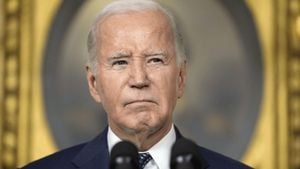Donald Trump’s recent threats to impose hefty tariffs on Mexican imports have sparked significant reactions from both sides of the border. The former president, on his platform Truth Social, proclaimed he would introduce a steep 25% tariff on all U.S. imports from Mexico if the neighboring nation does not succeed in curbing the flow of migrants and the drug fentanyl. His fiery declaration has raised eyebrows, with many experts viewing it as more of a campaign gimmick than a serious policy proposal.
This tactic, seen as leverage to manipulate Mexico’s actions, aims to present Trump as tough on immigration. But critics argue it oversimplifies complex bilateral issues and ignores some hard truths about border management.
Mexican President Claudia Sheinbaum responded sharply to Trump's threats, asserting Mexico's proactive measures against illegal immigration and drug trafficking—actions often overlooked by the American public. She pointedly remarked on the significant role American firearms play in fueling violence and crime within Mexico, implying this dangerous situation is intertwined with the U.S.'s own demand for drugs. “Tragically, it is our country where lives are lost to the violence resulting from fulfilling the drug demand from yours,” she remarked, emphasizing the need for cooperation rather than confrontation.
Importantly, Sheinbaum highlighted Mexico's own comprehensive strategies to assist migrants traversing the country en route to the U.S., asserting these efforts have led to remarkable decreases—up to 75%—in encounters at the border. This statistic, derived from U.S. Customs and Border Protection data, underlines the reality often disregarded by Trump's narrative of failure. The president-elect’s insistence on tariffs suggests he believes Mexico is not doing enough to stem the tide of migrants, which those versed in migration issues recognize as misleading.
Adam Isacson, who observes migration flows for the Washington Office on Latin America, has created charts showing the sizable number of migrants apprehended by Mexican authorities as they attempt to transit to the U.S. This includes tens of thousands of individuals each month. Despite Trump's claims of rampant illegal crossings, the data reveals the reality is more nuanced, with apprehension numbers fluctuated drastically due to various administrative efforts by the Biden administration and previous agreements with Mexico.
Further contributing to the decline of illegal border crossings is the Biden administration's initiative known as the CBP One app, which allows migrants to schedule appointments to enter the U.S. lawfully. Observers have noted Trump’s potential reversal on such effective policies if he retakes office, casting doubt on his commitment to genuine border security.
Reports from major publications like The Washington Post and The Wall Street Journal underline how the Mexican government has implemented strategic operations—referred to as “El Carrousel” or “the merry-go-round”—to transfer migrants back south through Mexico under organized efforts. This coordination reflects long-term engagement rather than simple compliance with demands from Washington.
Experts cite the collaboration between Mexico and the Biden administration as pivotal to these successes, with many asserting significant progress was achieved without resorting to threats or tariffs. Isacson notes, “If Trump wants Mexico to crack down on unauthorized migration through its territory, then Biden has already gotten Mexico to do more than anyone has previously.” This points to the reality of diplomatic works overshadowed by Trump’s prevailing narrative of coercive tactics.
The discourse surrounding Trump's tariff threats brings to light larger questions about public perception and prevailing narratives concerning immigration. Despite multifaceted realities, simplicity often prevails, leading to widespread misunderstandings among voters about the effectiveness of policy measures undertaken by the Mexican government. Many media outlets and political commentators appear to miss this point altogether, focusing instead on the potential economic fallout of the proposed tariffs.
Beyond economic concerns, Sheinbaum’s statements challenge the underlying premise of Trump’s authority on the matter, proposing instead the need for informed dialogue and action grounded in cooperation. The Mexican administration is already taking steps to manage migration and drug-related issues, often without the bluster associated with Trump’s approach.
Given the broader socio-political contexts involved, it becomes clear the path forward requires attention to the interrelated challenges faced by Mexico and the U.S. Diplomatic engagement, rather than punitive tariffs, may well represent the future of U.S.-Mexico relations. The insistence on punitive tariffs does not merely risk creating economic strife but also obscures potential paths for collaboration.
Observing the dynamics of this discussion, it becomes evident Trump’s portrayals of Mexico as inactive are necessarily misleading. The reality reveals much more active measures at play, driven by governments responding to shared challenges rather than simply reacting to threats. Sheinbaum’s articulate response emphasizes the progress Mexico has made, even as Trump attempts to undermine those successes.
With Trump set to return to political prominence, the implications of his stance are far-reaching. If historical patterns are any indicator, the reactions to his presidency will be laden with disinformation and conflicting narratives—underscoring the need for vigilance among voters to sift through political rhetoric.
Moving forward, the challenge remains for both nations to craft narratives and policies conducive to genuine cross-border partnerships. Complex issues like immigration and drug trafficking cannot be boiled down to simple solutions such as imposing tariffs. The need for comprehensive immigration reform and shared responsibility to address root issues will only grow.
Indeed, as both countries grapple with the realities at hand, one truth stands firm: Navigational pathways forward must be carved through informed dialogue, mutual respect, and collaborative action, rather than through the chaos of threats and bellicosity. The stakes are too high for anything less.



